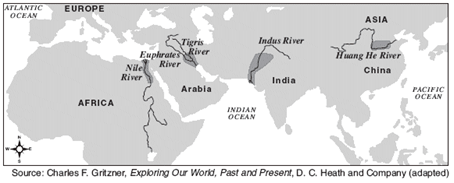Define Turning Point
An event that leads to lasting change
define food surplus
extra food; an abundance of food
What two innovations led to the turning point, the Neolithic Revolution?
The domestication of animals and agriculture
What landform did the first civilizations settle by?
Rivers
The river valleys of the Tigris-Euphrates, the Nile, and the Indus were centers of civilization because they
provided a means of fertile soil, irrigation, and transportation.
What was the turning point that took place AFTER the Paleolithic period?
Neolithic Revolution; the beginning of domestication of animals and agriculture
During which period did the domestication of animals and growing of crops first occur?
Neolithic Revolution
Terrace farming is a method of farming that uses “steps” known as terraces that are built onto the slopes of hills and mountains to be used for crop cultivation.
Define adapt
make something suitable for a new use or purpose; modify.
Mesopotamia was located in which modern-day country?
1. Peru
2. Iraq
3. Greece
Iraq
What does it mean to domesticate animals?
Agriculture led to the first _____________ to develop, establishing permanent settlements.
civilizations
How did irrigation systems help the Early River Valley Civilizations?
Irrigation systems helped early civilizations get water to their crops.
The Code of Hammurabi would align with which characteristic of a civilization?
Government
With fertile land and the ability to farm, civilizations experienced a food _________.
Surplus
Instead of hunting and gathering, people were now able to
farm
In order to farm on mountainous lands, __________ farming was innovated.
Terrace
Explain the techniques used creating a mud-brick.
1. Stomp out the mud, manure, and straw.
2. Pour mixture into brick mold.
3. Allow to dry in the sun for at least 15 days.
4. Heat with fire
The main purpose of this map is to illustrate the location of ________.
River valley civilizations
Explain how population growth is connected with the Neolithic Revolution.
Food surpluses meant that civilizations could keep more people alive, therefore the population increased.
Instead of being nomadic, people were now able to
settle in permanent homes
Because they needed to get water to where they needed it, early civilizations innovated by creating __________ ____________.
Irrigation systems
Explain how one innovation we have talked about has had an impact on future civilizations to come.
(teacher's discretion)
Name the 7 characteristics of a civilization
technology, government, religion, cities, job specialization, social hierarchy, language.
Mesopotamia means the "land between two rivers". Which two rivers was Mesopotamia between?
Euphrates and the Tigris